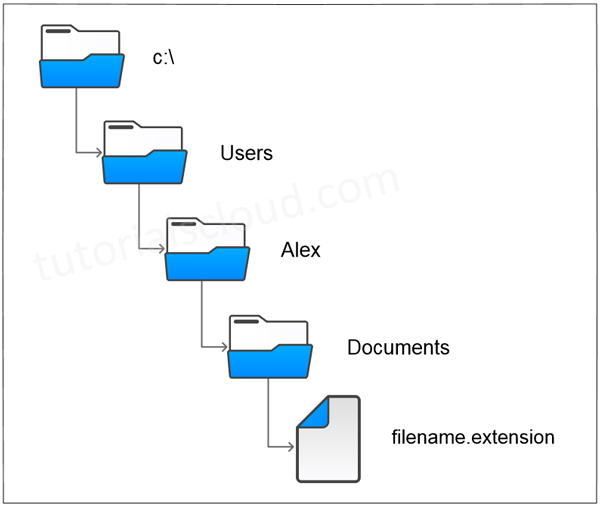Python File Handling
All programs need the input to process and output to display data. And everything needs a file as name storage compartments on computers that are managed by OS. Though variables provide us a way to store data while the program runs, but if we want out data to persist even after the termination of program, we have to save it to a file.
File and its path
There are always two parts of a file in computer system, the filename and its extension. Also the files have two key properties – its name and the location or path, which specifies the location where the file exists. The file name has two parts and they are separated by a dot (.) or period.
Figure – File and its path:

A built-in open method is used to create a Python file-object, which provides a connection to the file that is residing on programmer’s machine. After calling the function open, programmers can transfer strings of data to and from the external file that is residing in the machine.
File Opening In Python
open() function is used to open a file in Python. It’s mainly required two arguments, first the file name and then file opening mode.
Syntax:
file_object = open(filename [,mode] [,buffering])
In the above syntax the parameters used are:
Modes Of Opening File In Python
The file can be opened in the following modes:
| Mode | Description |
|---|---|
| r | Opens a file for reading only. (It’s a default mode.) |
| w | Opens a file for writing. (If file doesn’t exist already, then it’s creates a new file, otherwise it’s truncate a file.) |
| x | Opens a file for exclusive creation. (Operation fails if file does not exists in location.) |
| a | Opens a file for appending at the end of the file without truncating it. (Creates a new file if it does not exist in location.) |
| t | Opens a file in text mode. (It’s a default mode.) |
| b | Opens a file in binary mode. |
| + | Opens a file for updating (reading and writing.) |
File Object Attributes
If an attempt to open a file fails then open returns a false value, otherwise it returns a file object that provides various information related to that file.
Example:
#!/usr/bin/python
# file opening example in Python
fo = open("sample.txt", "wb")
print "File Name: ", fo.name
print "Mode of Opening: ", fo.mode
print "Is Closed: ", fo.closed
print "Softspace flag : ", fo.softspaceOutput:
File Name: sample.txt
Mode of Opening: wb
Is Closed: False
Softspace flag: 0
File Reading In Python
For reading and writing text data different text-encoding schemes are used such as ASCII (American Standard Code for Information Interchange), UTF-8 (Unicode Transformation Format), UTF-16.
Once a file is opened using open() method then it can be read by a method called read().
Example:
#!/usr/bin/python
# read the entire file as one string
with open('filename.txt') as f:
data = f.read()
# Iterate over the lines of the File
with open('filename.txt') as f:
for line in f :
print(line, end=' ')
# process the linesFile Writing In Python
Similarly for writing data to files, we have to use open() with ‘wt‘ mode, clearing and overwriting the previous content. Also we have to use write() function to write into a file.
Example:
#!/usr/bin/python
# Write text data to a file
with open('filename.txt' , 'wt') as f:
f.write ('hi there, this is a first line of file.\n')
f.write ('and another line.\n')Output:
hi there, this is a first line of file.
and another line.
By default, in Python – using the system default text encoding files are read/written. Though Python can understand several hundred text-encodings but the most common encoding techniques used are ASCII, Latin-1, UTF-8, UTF-16 etc. The use of ‘with’ statement in the example establishes a context in which the file will be used. As the control leaves the ‘with’ block, the file gets closed automatically.
Writing A File That Does Not Exists
The problem can be easily solved by using another mode – technique i.e. the ‘x‘ mode to open a file instead of ‘w‘ mode.
Let’s see two examples to differentiate among them.
Example:
#!/usr/bin/python
with open('filename' , 'wt') as f:
f.write ('Hello, This is sample content.\n')
# This will create an error that the file 'filename' doesn't exist.
with open ('filename.txt' , 'xt') as f:
f.write ('Hello, This is sample content.\n')In binary mode, we should use ‘xb‘ instead of ‘xt‘.
Closing A File In Python
In Python, it is not system critical to close all your files after using them, because file will auto close after Python code finishes execution. You can close a file by using close() method.
Syntax:
file_object.close();
Example:
#!/usr/bin/python
try:
# Open a file
fo = open("sample.txt", "wb")
# perform file operations
finally:
# Close opened file
fo.close()
Comments
Post a Comment